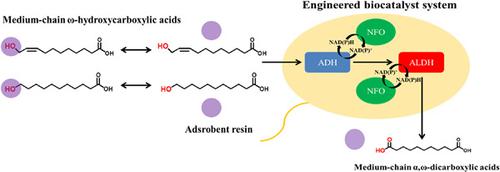当前位置:
X-MOL 学术
›
Biotechnol. Bioeng.
›
论文详情
Our official English website, www.x-mol.net, welcomes your
feedback! (Note: you will need to create a separate account there.)
Construction of an engineered biocatalyst system for the production of medium-chain α,ω-dicarboxylic acids from medium-chain ω-hydroxycarboxylic acids.
Biotechnology and Bioengineering ( IF 3.5 ) Pub Date : 2020-05-21 , DOI: 10.1002/bit.27433 Tae-Hun Kim 1 , Su-Hwan Kang 1 , Jin-Byung Park 2 , Deok-Kun Oh 1
Biotechnology and Bioengineering ( IF 3.5 ) Pub Date : 2020-05-21 , DOI: 10.1002/bit.27433 Tae-Hun Kim 1 , Su-Hwan Kang 1 , Jin-Byung Park 2 , Deok-Kun Oh 1
Affiliation

|
Medium‐chain α,ω‐dicarboxylic acids produced from renewable long‐chain fatty acids are valuable as precursors in the chemical industry. However, they are difficult to produce biologically at high concentrations. Although improved biocatalyst systems consisting of engineering of Baeyer–Villiger monooxygenases are used in the production of ω‐hydroxycarboxylic acids from long‐chain fatty acids, the engineering of biocatalysts involved in the production of α,ω‐dicarboxylic acids from ω‐hydroxycarboxylic acids has been rarely attempted. Here, we used highly active bacterial enzymes, Micrococcus luteus alcohol dehydrogenase and Archangium violaceum aldehyde dehydrogenase, for the efficient production of α,ω‐dicarboxylic acids from ω‐hydroxycarboxylic acids and constructed a biocatalyst with cofactor regeneration system by introducing NAD(P)H flavin oxidoreductase as the NAD(P)H oxidase. The inhibition of the biocatalyst by hydrophobic substrates was attenuated by engineering a biocatalyst system with an adsorbent resin, which allowed us to obtain 196 mM decanedioic, 145 mM undecanedioic, and 114 mM dodecanedioic acid from 200 mM of C10, C11, and C12 hydroxyl saturated carboxylic acids, respectively, and 141 mM undecanedioic acid from 150 mM C11 unsaturated carboxylic acids, with molar conversions of 98%, 97%, 95%, and 94%, respectively. The concentration of undecanedioic acid obtained was approximately 40‐fold higher than that in the previously highest results. Our results from this study can be applied for the industrial production of medium‐chain α,ω‐dicarboxylic acids from renewable long‐chain fatty acids.
中文翻译:

构建用于从中链 ω-羟基羧酸生产中链 α,ω-二羧酸的工程生物催化剂系统。
由可再生的长链脂肪酸生产的中链 α,ω-二羧酸作为化学工业的前体很有价值。然而,它们难以以高浓度生物生产。尽管由 Baeyer-Villiger 单加氧酶工程组成的改进生物催化剂系统用于从长链脂肪酸生产 ω-羟基羧酸,但涉及从 ω-羟基羧酸生产 α,ω-二羧酸的生物催化剂工程已经很少尝试。在这里,我们使用了高活性细菌酶、藤黄微球菌醇脱氢酶和紫锥菊醛脱氢酶,用于从 ω-羟基羧酸有效生产 α,ω-二羧酸,并通过引入 NAD(P)H 黄素氧化还原酶作为 NAD(P)H 氧化酶,构建具有辅因子再生系统的生物催化剂。通过设计带有吸附树脂的生物催化剂系统,疏水底物对生物催化剂的抑制作用减弱,这使我们能够从 200 mM C10、C11 和 C12 羟基饱和中获得 196 mM 癸二酸、145 mM 十一烷二酸和 114 mM 十二烷二酸羧酸,以及来自 150 mM C11 不饱和羧酸的 141 mM 十一烷二酸,摩尔转化率分别为 98%、97%、95% 和 94%。获得的十一烷二酸的浓度比之前的最高结果高约 40 倍。
更新日期:2020-05-21
中文翻译:

构建用于从中链 ω-羟基羧酸生产中链 α,ω-二羧酸的工程生物催化剂系统。
由可再生的长链脂肪酸生产的中链 α,ω-二羧酸作为化学工业的前体很有价值。然而,它们难以以高浓度生物生产。尽管由 Baeyer-Villiger 单加氧酶工程组成的改进生物催化剂系统用于从长链脂肪酸生产 ω-羟基羧酸,但涉及从 ω-羟基羧酸生产 α,ω-二羧酸的生物催化剂工程已经很少尝试。在这里,我们使用了高活性细菌酶、藤黄微球菌醇脱氢酶和紫锥菊醛脱氢酶,用于从 ω-羟基羧酸有效生产 α,ω-二羧酸,并通过引入 NAD(P)H 黄素氧化还原酶作为 NAD(P)H 氧化酶,构建具有辅因子再生系统的生物催化剂。通过设计带有吸附树脂的生物催化剂系统,疏水底物对生物催化剂的抑制作用减弱,这使我们能够从 200 mM C10、C11 和 C12 羟基饱和中获得 196 mM 癸二酸、145 mM 十一烷二酸和 114 mM 十二烷二酸羧酸,以及来自 150 mM C11 不饱和羧酸的 141 mM 十一烷二酸,摩尔转化率分别为 98%、97%、95% 和 94%。获得的十一烷二酸的浓度比之前的最高结果高约 40 倍。











































 京公网安备 11010802027423号
京公网安备 11010802027423号